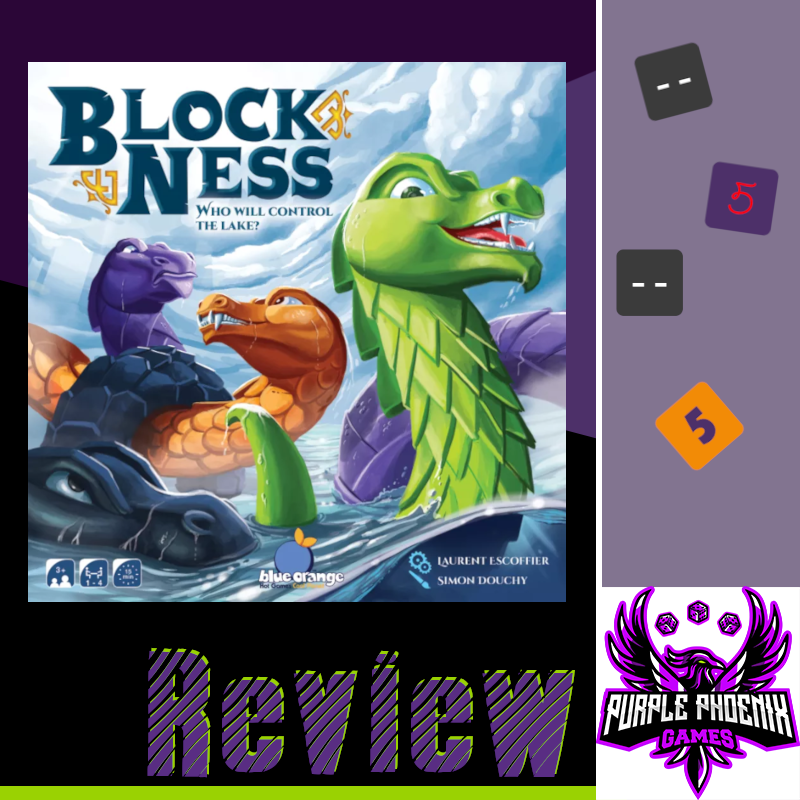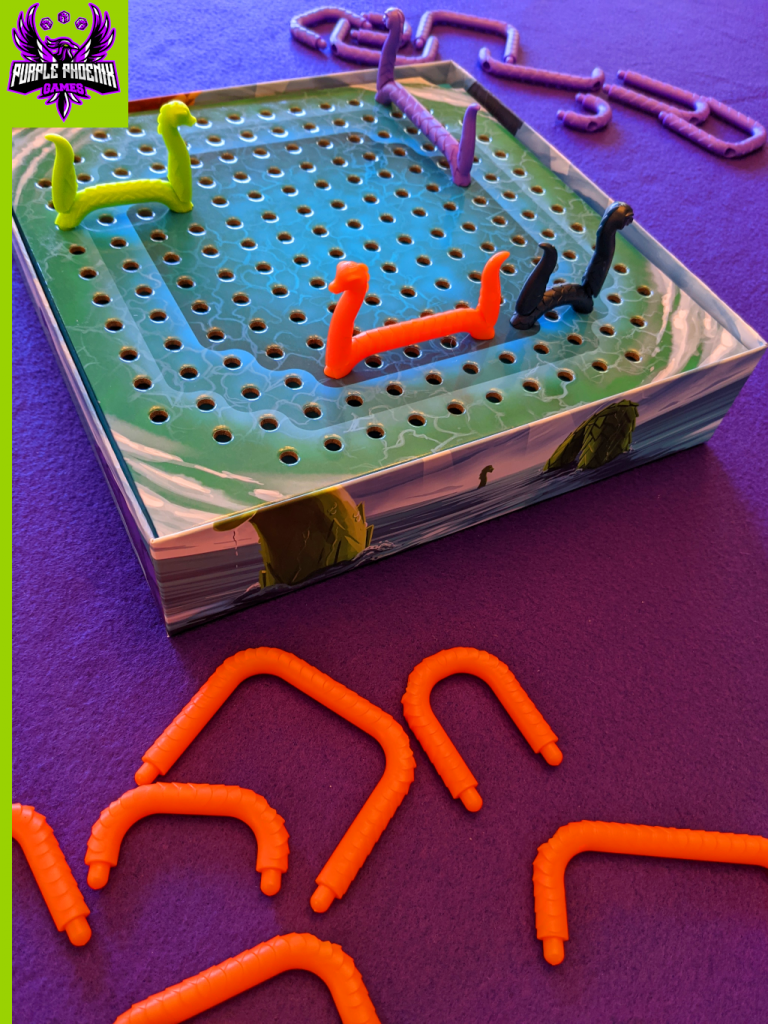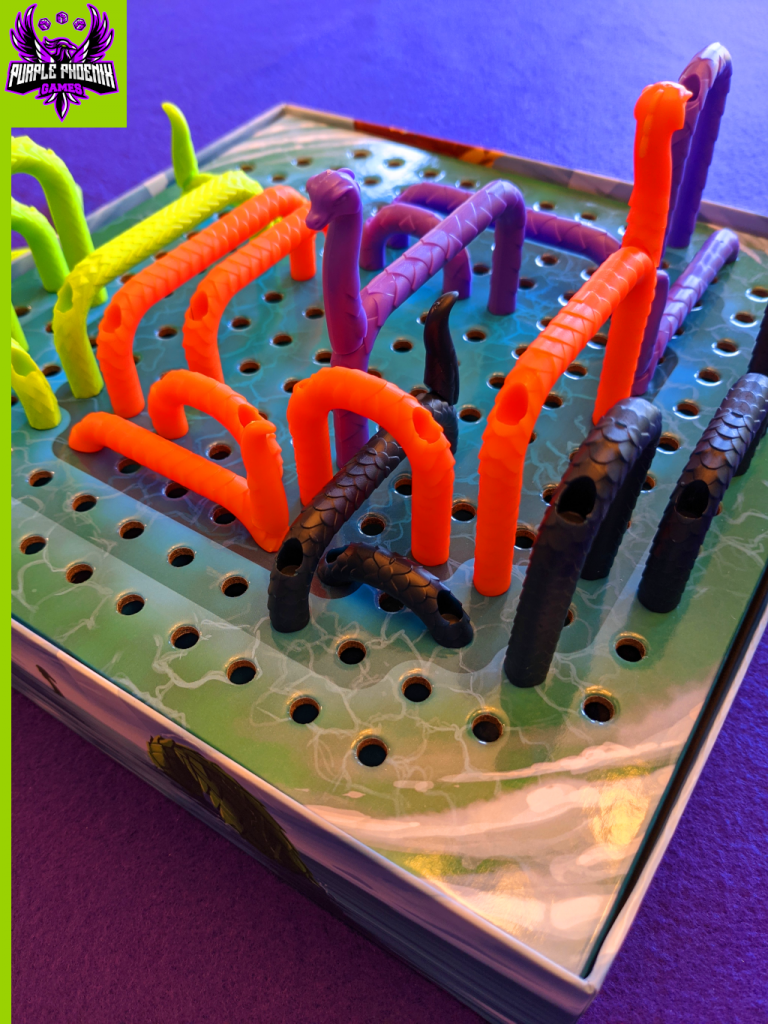
The Loch Ness monster has been a thorn in the side of believers for so long now. We recently published a preview for a Sasquatch game, and a game featuring a werewolf. Today it’s Nessie’s turn. But this game isn’t necessarily about Nessie, but of giant water serpents vying for control over the too-small lake in which they find themselves. How did they get there? What do they eat? Will they truly come to get me if I don’t brush my teeth? I don’t know the answer to some of those questions, but here’s another: is a game about these creatures good?
| Block Ness (2021) | Blue Orange Games |
| 2-4 Players | 15-20 minutes |
| Ages 8+ | BGG Weight – (not yet available) |
Block Ness is a connections game with big chunky bits where players are taking on the mantles of ever-expanding water serpents attempting to stretch themselves out as long as possible. The winning serpent is they who either is able to stretch out furthest (by using all of their body pieces), or who is able to reach for the sun the furthest (by having the tallest head piece at game end).
DISCLAIMER: We were provided a copy of this game for the purposes of this review. This is a retail copy of the game, so what you see in these photos is exactly what would be received in your box. I do not intend to cover every single rule included in the rulebook, but will describe the overall game flow and major rule set so that our readers may get a sense of how the game plays. For more in depth rules, you may purchase a copy online or from your FLGS. -T
To setup, place the peg board on top of the insert in the box. This signifies the lake and where the game will take place. Each player chooses a color of serpent and takes all the corresponding pieces in front of them. Each serpent has a starting body piece that is shorter than all the other pieces, and must be placed first. The youngest player places their first piece on the board, within the darkest inner colors of the lake (UNlike the setup pictured below. Sometimes you just HAVE to let little ones place wherever they like to avoid ACTUAL monster spawns). The other players follow in turn order and attach the head and tail pieces to either end of the starting segments. The game is now setup and ready to begin!

On a turn, the active player will choose a body piece to add to their serpent at either the head or tail location. Players are limited to the three spaces adjacently surrounding the head and tail segments (akin to the compass markings of North, East, South, West). The new body segment then receives either the head or tail piece on its end to signify the new growth of the serpent. No body segments may be placed in a diagonal fashion, and there will come a time when serpents will need to get creative in order to place.
Should a serpent wish to expand through an existing player’s body segment, they may only do so if they are able to place said piece ABOVE the existing segment. For example, the photo below shows the orange serpent slithering above a portion of the black serpent (whose placement now looks somewhat illegal anyway). No matter where the segment is placed the head or tail piece will need to be moved to the newly-placed segment to allow for further expansion on future turns.
Play continues in this fashion until one player has the least leftover body segments without a legal placement, or controls the serpent with the tallest head among the tied players. The winner then must gloat and challenge the others to another game.

Components. This game has great 3D serpent pieces and a nice little peg board to play on. I truly love when games include the box as part of gameplay, and this uses it well. The art and colors used throughout are simply perfect (thank you for not using boring blue, red, yellow, green). The only tiny gripe I have is more of a hope than anything. I hope that upon many many plays the peg board stays nice and doesn’t deteriorate. I realize it’s a game and it’s made out of cardboard. I know many people love seeing their games age because it shows a well-loved item, but I’m not like that. I like my games to always look new. Perhaps if the peg board ever does warp or get damaged in any way I may look into having a plexi replacement made. But that aside, this is a beautiful game with excellent components, and exactly what I would expect from Blue Orange Games.
So do I like this one? Oh yes, quite a bit! Though it is not exactly the same, I believe this may kill off an old family favorite of mine – Blokus. Again, this is not a re-theme of Blokus at all, but it certainly gives me the same vibes, but in three dimensions and with much greater flair. In both games players are actively trying to block each others’ expansion progress, but Block Ness offers a smaller board and way less pieces with which to play. This creates a more tense game in a shorter time frame, and you play with serpent monsters!!
The serpents are all so much fun to handle, and while I initially though moving the head and tail pieces would get annoying after a while, I quite enjoy seeing my new serpent monster after their endpoints are reattached. Like I mentioned earlier, I very much appreciate being able to play orange, purple, black, and a yellowy-green very similar in color to our highlight color we use for our brand. Super happy about those color choices.
All in all, to say this slays Blokus is a huge thing for me. My wife and I absolutely adore Blokus, but I think I would much rather play Block Ness. I also can play this with my kids much easier and not have to worry about one of them losing the 1×1 pieces. I am certainly not alone in recommending this one. Purple Phoenix Games gives this a legendary 10 / 12. I would be surprised if this doesn’t intrigue most gamers of almost any skill and preference. There is much strategy to be employed, and an equal amount of frustration as the serpents block in other opponents. While I have no desire to try to see the actual Loch Ness monster, I will ALWAYS be up for a game of Block Ness.

